The AMD Kabini Review: A4-5000 APU Tested
by Jarred Walton on May 23, 2013 12:00 AM ESTKabini Gaming and Battery Life
We've covered the general performance and some synthetic graphics tests. What about actual games? Well, here’s what our (admittedly punishing) 2013 gaming suite looks like on Kabini. These are the "Value" results, as the "Mainstream" and "Enthusiast" settings are unplayable on anything without a dGPU (though those results are available in Mobile Bench if you're interested).
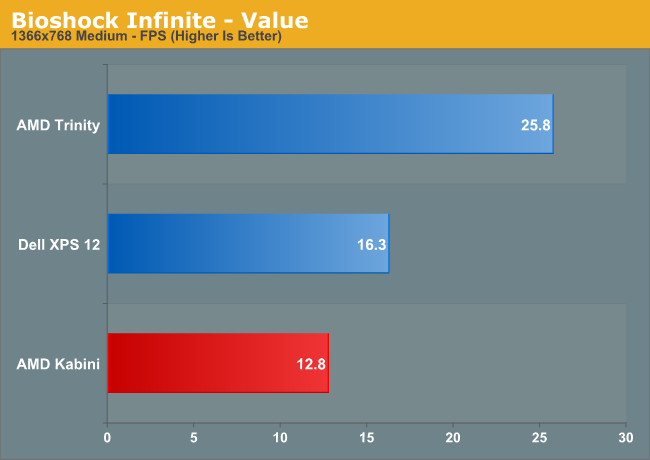

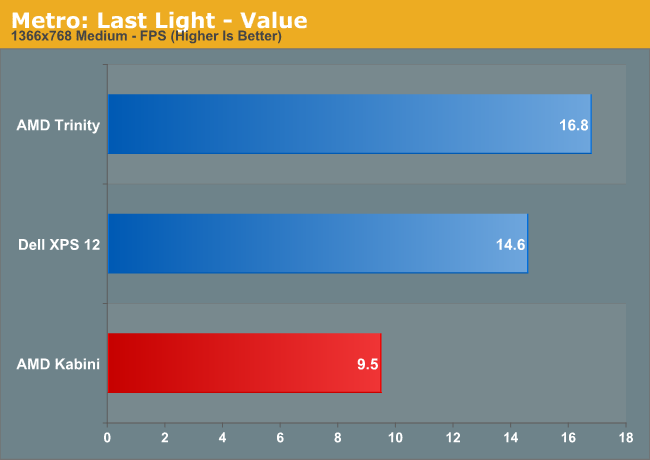
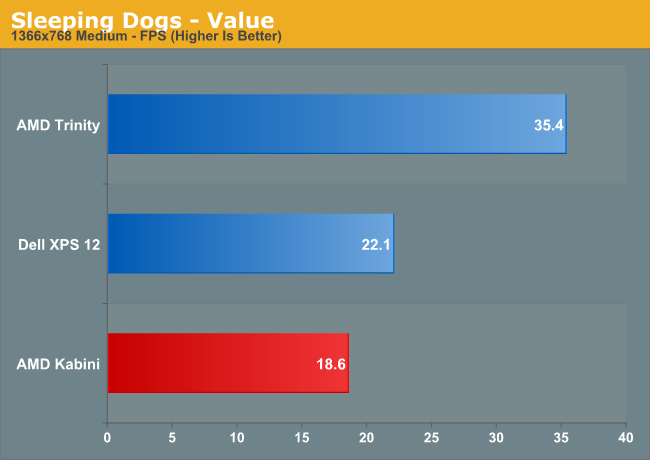
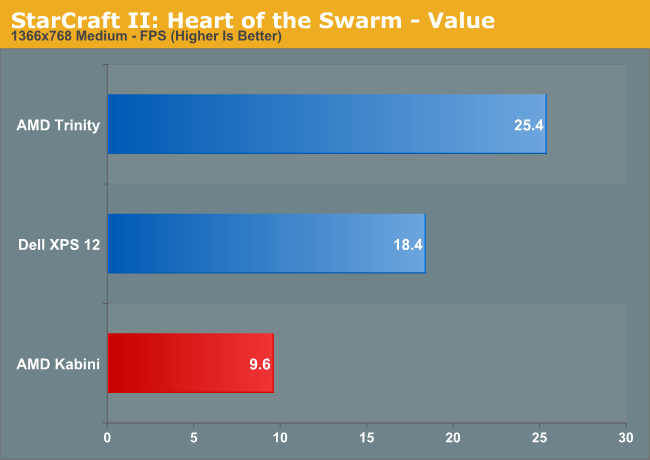
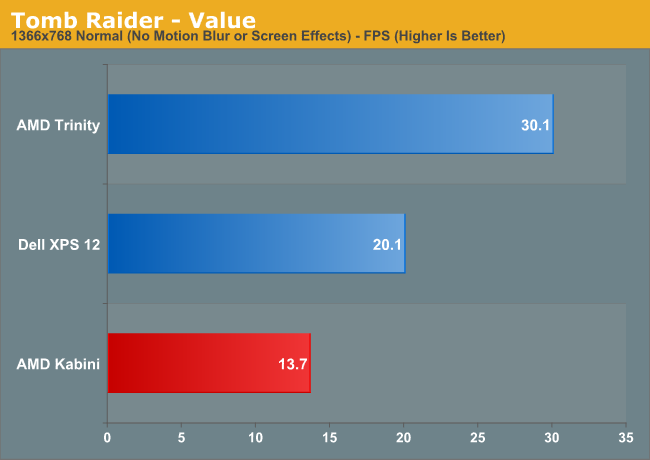
The short summary is that not a single game manages to crest the 30FPS mark, and I even ran additional tests at the minimum quality settings (at 1366x768) to see if I could improve the results. Sadly, I couldn’t, at least not enough to make the games playable; the best I managed was around 25 FPS in Bioshock, Skyrim, and Tomb Raider at minimum detail, and most titles remained in the sub-20 FPS range. Titles that tend to be more taxing on the CPU side of things like StarCraft II are even worse, with frame rates in StarCraft II being half of what IVB ULV gets at our Value (medium quality minus antialiasing) preset.
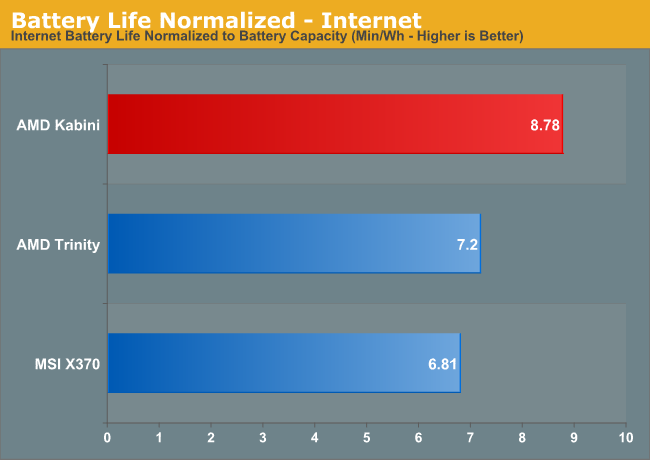
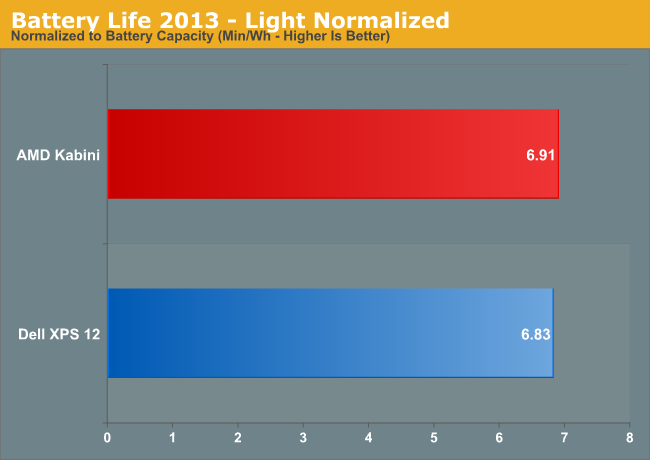
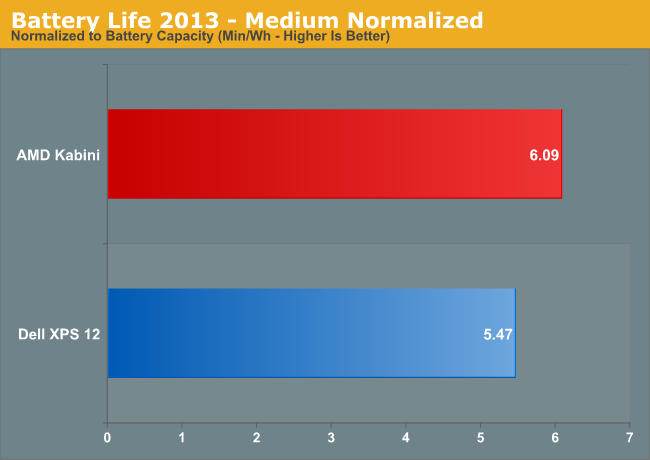
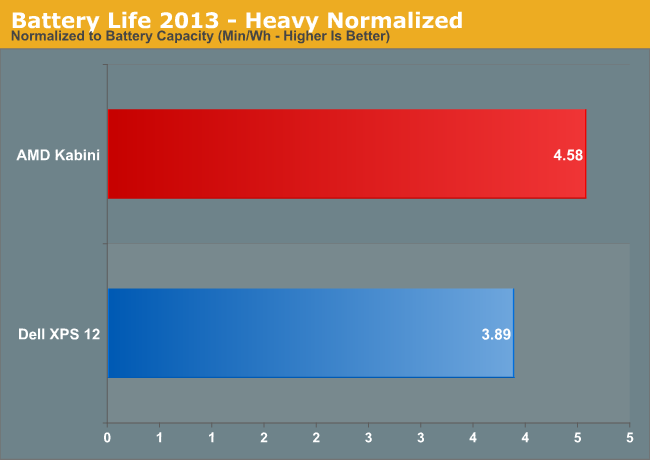
The good news is that not only is Kabini noticeably faster than Brazos, but it’s also mighty frugal when it comes to power use. We don’t have any Brazos laptops handy, so we had to use our older Internet battery life test as a comparison point (100 nits instead of 200 nits); in that test, Kabini topped 6.5 hours with a 45Wh battery. The MSI X370 we’re using as a comparison point did last a bit longer, but it also has a 64Wh battery. In terms of normalized power use, the Kabini laptop ends up being 29% more efficient, and that’s with a 14” AHVA 1080p panel going up against a 13.3” TN 768p display. We’re not quite able to compare apples to apples, but Kabini definitely looks like a good improvement over Brazos in power use.
The power story is even better when we look at ULV Ivy Bridge and standard Trinity APUs. Using our new battery life tests, which push the hardware a lot harder than our previous tests, Kabini delivers normalized battery life that’s at least equal to IVB ULV (our “Light” test), and in the more taxing Medium and Heavy tests Kabini beats ULV by 11% and 18%, respectively. Of course the IVB ULV system is still faster, and it’s also likely to cost twice what we expect Kabini laptops to sell for, but lower cost Celeron and Pentium ULV parts shouldn't be all that different. Also of note is that we don’t know yet how Haswell will fare in these same tests, but that’s an area Intel seems to be focusing on for their next CPU; that’s a story for next month….










130 Comments
View All Comments
whyso - Thursday, May 23, 2013 - link
kabini only has a single channel memory controller. Going to two DIMMS would not improve performance at all.Gaugamela - Thursday, May 23, 2013 - link
He didn't mention dual channel memory not even once in his comment. He mentioned comparing a inexpensive chip that competes against Atoms/Pentiums in price/performance/TDP with an intel i5 which is a much more powerful chip.Roland00Address - Thursday, May 23, 2013 - link
I wonder how starvered the cores are for memory bandwith. Even the xbox one will be using quad channel memory (4 64 bit controllers) and 2133 mhz instead of 1600, that is over five times the bandwidth. The ps4 keeps the quad channel but uses gddr5 memorywhyso - Thursday, May 23, 2013 - link
Well the xbox one has 6x the igp and the ps4 has 9x the igp.Roland00Address - Thursday, May 23, 2013 - link
I am not asking if the gpu is bandwidth starved but is the cpu bandwidth starvedI understand why amd went single channel, I am just curious if dual channel would make a difference
whyso - Thursday, May 23, 2013 - link
CPU is almost never bandwidth starved. Literally, you can run a 3770k on 1033 mhz ram and outside winrar you will never notice any differences compared to 2133 mhz ram. 3770k is dual channel but more than 4x as powerful as this kabini apu.Roland00Address - Thursday, May 23, 2013 - link
Your statement that an i7 does not need faster memory does not necessarily translate to this situation with jaguar and that is why I am curious if the cores are starved. I wish it was possible for anandtech to test this (but it is very hard to do so for there isn't really laptop ram faster than 1600 mhz for laptops). Here is why you can't just assume what works with an i7 translates with the jaguar chip.533 mhz dual channel is equivalent to 1066 single channel. (Remember i7-3770k is dual channel while amd jaguar in this implementation is single channel). Thus you can't just assume an i7 is fine with dual channel, than the jaguar would be fine with single channel for the i7 has 100% more bandwidth due to it being dual channel.
Furthermore i7-3770k is intels high performance architecture with large r&d vs amd's energy efficent architecture with small r&d chip. It is very likely intel has better data predictors in their i7 so there's less cache miss and thus you don't care about the memory speed. Intel R&D money is a big deal and translates into better IPC for many reasons including branch prediction.
Lets put it this way arm is going higher bandwidth for more ipc. Tegra 3 is a mere single channel 32 bit controller, Tegra 4 is likely to be a dual channel 32 bit controller, Exynos 5 uses a dual channel 32 bit controller. Apple on their Ipads now use a quad channel 32 bit controller. One reason why exynos and ipad were faster than tegra 3 was better memory bandwidth.
I am not saying you will see improvements greater than 20% but I am curious if faster memory speeds would cause ipc to go up from 5 to 20%. For example with bulldozer amd gets 8% faster encoding with x264 first pass with 2133 memory dual channel instead of 1333 dual channel according to vr-zone.
It may not be in amd best interest to make the jaguar chip dual channel 64 bit for cheap laptops that compete against intel's celeron or pentium lines, for laptops. Yet at the same time Jaguar is going to be AMD process for low power in the future. It is quite possible that AMD may in the future (if the tdp is low enough) make a 20nm dual channel chip for the higher margin tablets, high margin tablets would insist on higher ipc for the cpu and more bandwidith for the screen, while low margin cheap computers would not care about increase ipc. It is possible that in the future AMD can find a sweet spot between intel atom and intel haswell. (I am not saying this is likely, just merely possible all depends on intel's pricing to oems for haswell.)
whyso - Thursday, May 23, 2013 - link
It is extremely unlikely for this chip's cpu to be hurt by memory bandwidth. Sure the i7 has 100% more bandwidth but you must factor in the power of the chip. The i7-3770k is going to be something like 6x more powerful (3.7 ghz turbo + IPC advantage + HT). Even if the kabini chip tested in this review was half as efficient as the 3770k in utilizing memory bandwidth it still wouldn't show any differences in cpu performance.Phone/tablet SOCs mainly need the bandwidth for the gpu portion of the die (the high res screen was the reason that apple needed such an interface). If they need more bandwidth it'll be for the igp portion of the die (definitely 1066 mhz ram on a single channel will hurt this thing) for kabini.
geoflouw - Thursday, May 23, 2013 - link
Need a comparison against Haswell and Baytrail please. This data is misleading, i really would hope AMD can compete with 1 year old CPUs and SOCs.....smilingcrow - Thursday, May 23, 2013 - link
It’s hardly misleading. Haswell is still under NDA and Bay Trail is due around Q4 which is why they aren’t compared. The better comparison will be Bail Trail based on pricing and performance. AMD should still have a healthy lead for GPU but if Intel’s recent info is true it should be close on the CPU front. The main difference is that Bay Trail has a low enough TDP for a cheap fanless tablet whereas the chip reviewed today is 15W so Ultrabook class. So you get two out of four with AMD:The Good: GPU + Price
The Bad: power consumption + low IPC
So business as usual really.